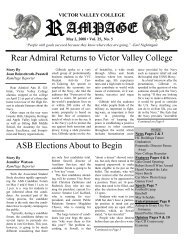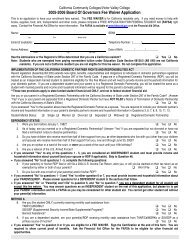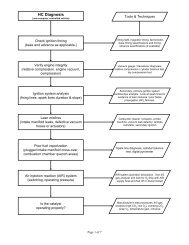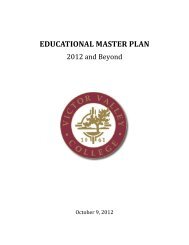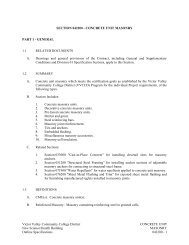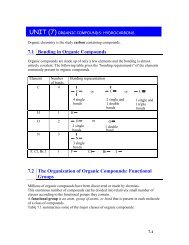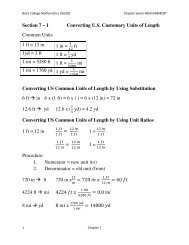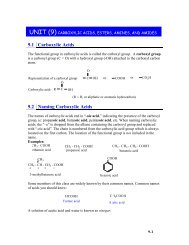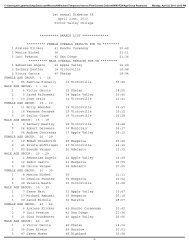Educational Rights and Privacy Act of 1974 (FERPA - Victor Valley ...
Educational Rights and Privacy Act of 1974 (FERPA - Victor Valley ...
Educational Rights and Privacy Act of 1974 (FERPA - Victor Valley ...
Create successful ePaper yourself
Turn your PDF publications into a flip-book with our unique Google optimized e-Paper software.
Financial Aid Brochure blue 2006-2007.indd, Spread 1 <strong>of</strong> 6 - Pages (12, 1) 5/15/2006 11:33 AM4. Name change (for example, maiden name to married name)5. You transfer to another schoolAll information contained in a student’s financial aid application <strong>and</strong> file is h<strong>and</strong>led confidentially by the Financial Aid Office. This is governed under the terms <strong>of</strong> the Family<strong>Educational</strong> <strong>Rights</strong> <strong>and</strong> <strong>Privacy</strong> <strong>Act</strong> <strong>of</strong> <strong>1974</strong> (<strong>FERPA</strong>.) All documentation submitted becomes part <strong>of</strong> the student’s file <strong>and</strong> will not be returned. Due to <strong>FERPA</strong>, we are unable toanswer specific questions on a student’s file over the telephone. The student must be present in order to discuss his/her file at the financial aid window, with a valid California I.D. orDriver’s License.<strong>Victor</strong><strong>Valley</strong>CollegeFINANCIAL AID AND YOU:“Working Together for Student Success”TERMS AND CONDITIONS OF FINANCIAL AID AWARDS:Although the primary responsibility for paying for a college education rests with the student <strong>and</strong> their families, financial aid is available to help you. It is intended to supplement,not replace, the resources students <strong>and</strong> their families have.Your Financial Aid package is based both on your predetermined need <strong>and</strong> the funds available at the college at the time you complete your file. Your need is determined by takingthe Cost <strong>of</strong> Education at the college <strong>and</strong> subtracting your EFC from your SAR. The Department <strong>of</strong> Education has an established formula <strong>and</strong> the information you provide on yourFAFSA is used to determine your EFC. The Cost <strong>of</strong> Education includes not only direct expenses (tuition <strong>and</strong> fees), but also an estimate <strong>of</strong> indirect costs (transportation, books, <strong>and</strong>living expenses.)Financial Aid awards are based on the assumption that students <strong>and</strong> parents have submitted truthful <strong>and</strong> correct information. If information used in awarding financial aid isdetermined to be incorrect, the financial aid awarded may be adjusted or changed. This applies to instances where incorrect information is used in the calculation due to:• Estimated information which proves to be incorrect• Incorrect information due to misunderst<strong>and</strong>ing <strong>of</strong> instructions• Additional outside grants or scholarships received from any source• Data entry errors on the part <strong>of</strong> the FAFSA processor or <strong>Victor</strong> <strong>Valley</strong> College• False informationIn cases <strong>of</strong> fraudulent information, any financial aid awarded will be cancelled <strong>and</strong> the case referred to the proper authorities.Students must inform the Financial Aid Office <strong>of</strong> any change in unit load from that initially reported on the financial aid application. Financial aid awards are based inpart on unit load, <strong>and</strong> any change may result in a change in eligibility.Regardless <strong>of</strong> the amount <strong>of</strong> financial aid anticipated, students are expected to arrive on campus with sufficient cash for expenses that will be incurred at the beginning<strong>of</strong> the year. Students should plan on bringing at least $100-$400 to cover these expenses. Financial aid proceeds should not be used as the primary means <strong>of</strong> support.There is <strong>of</strong>ten a delay between the time an application is filed <strong>and</strong> when payment is received. Students should have adequate funds to pay their day to day livingexpenses, including books <strong>and</strong> supplies, until disbursement is received. Due to the availability <strong>of</strong> funds <strong>and</strong> the dem<strong>and</strong> for these funds, students are sometimes leftwith an unfulfilled unmet need.Federal regulations prohibit us from paying you for classes prior to ten days from the scheduled start date.Legislation <strong>and</strong> governmental regulations are continually changing the face <strong>of</strong> student financial aid. The information contained inthis brochure is correct as <strong>of</strong> the time <strong>of</strong> publication (5/2009.) However, information is subject to change without notice.Form written <strong>and</strong> developed by Greg Ryan 5/20082009 - 2010Academic YearFinancial Aid is available in the form <strong>of</strong> grants, scholarships, work-study <strong>and</strong> student loans. Don’tdisqualify yourself by not applying <strong>and</strong> don’t assume you will not qualify.Students normally receive one or more types <strong>of</strong> funds.FINANCIAL AID OFFICE MISSION:The mission <strong>of</strong> the Financial Aid Department is to provide information <strong>and</strong> financial aid support toall eligible students attending <strong>Victor</strong> <strong>Valley</strong> College. We are devoted to the educational needs <strong>of</strong> allindividuals in the community <strong>and</strong> the varying specific educational needs <strong>of</strong> our students. Whateveryour major or career goal, we hope this publication will answer some <strong>of</strong> the questions you mayhave regarding Financial Aid <strong>and</strong> the application process at <strong>Victor</strong> <strong>Valley</strong> College. We hope togive you a clear picture <strong>of</strong> the options available to you as you plan your educational goals <strong>and</strong>budget for related expenses. Our motto is “Financial Aid <strong>and</strong> You: Working Together for StudentSuccess.” We are eager to serve you <strong>and</strong> wish you success!INTRODUCTION:Any student or potential student is encouraged to inquire about theeligibility requirements for receiving financial aid. We believe nostudent should be denied access to the educational experience because <strong>of</strong>lack <strong>of</strong> funds. If you need help with the cost <strong>of</strong> attending <strong>Victor</strong> <strong>Valley</strong>College, the Financial Aid Office may be able to assist you. TheFinancial Aid Office makes limited funds available to assiststudents in need. Our <strong>of</strong>fice has information on the FederalPell Grant, Academic Competitiveness Grant, Cal Grant, Board<strong>of</strong> Governor’s Fee Waiver, Federal Work Study, Federal FamilyEducation Loan Program, Supplemental <strong>Educational</strong> OpportunityGrant, Chafee Grant, Scholarships <strong>and</strong> VA benefits.Since financial aid opportunities <strong>and</strong> regulations change periodically, you shouldcheck with the Financial Aid Office each semester, regardless <strong>of</strong> how successfulyou were in obtaining aid in the past.<strong>Victor</strong> <strong>Valley</strong> College Financial Aid Office18422 Bear <strong>Valley</strong> Road, <strong>Victor</strong>ville, CA 92395-5850Phone: 760-245-4271 x2277 • Fax: 760-843-7707www.vvc.edu/<strong>of</strong>fices/financial-aid/index.htmWe are located in the Student Services I Building (#52) on the upper campus.You may also reach us by telephone at (760) 245-4271 X. 2277, by email at financialaid@vvc.eduor on the web at http://www.vvc.edu/<strong>of</strong>fices/financial-aid/index.htm.
Financial Aid Brochure blue 2006-2007.indd, Spread 2 <strong>of</strong> 6 - Pages (2, 11) 5/15/2006 11:33 AMFINANCIAL AID OFFICE STAFF:Greg Ryan, Director, Financial Aid............................................................................................................................................................ ryang@vvc.eduDiane Foxworthy, Financial Aid Specialist................................................................................................................................................. foxworthydi@vvc.eduGina Janisko, Financial Aid Specialist....................................................................................................................................................... janiskog@vvc.eduJim Murray, Financial Aid Specialist......................................................................................................................................................... murrayj@vvc.eduElaine Navarrete, Financial Aid Specialist................................................................................................................................................. navarretee@vvc.eduRobbie Richards, Financial Aid Specialist.................................................................................................................................................. richardsr@vvc.eduDee Melendez, Financial Aid Specialist, Bilingual...................................................................................................................................... melendezd@vvc.eduErnestine Jordan, Financial Aid Specialist................................................................................................................................................. jordane@vvvc.eduMartha Mendez, Financial Aid Technician, Bilingual.................................................................................................................................. mendezm@vvc.eduPamela Penl<strong>and</strong>, Administrative Secretary I.............................................................................................................................................. penl<strong>and</strong>p@vvc.eduVeronica Manriquez, Placement Specialist................................................................................................................................................ manriquezv@vvc.eduFINANCIAL AID OFFICE HOURS:Fall <strong>and</strong> Spring Hours:Monday <strong>and</strong> TuesdayWednesday, Thursday, Friday8:30 AM – 7:00 PM8:30 AM – 4:30 PMSummer Hours:Monday <strong>and</strong> TuesdayWednesday, Thursday, Friday7:30 AM – 7:00 PM7:30 AM – 4:30 PMFINANCIAL AID LABS:The Financial Aid Office <strong>of</strong>fers labs <strong>and</strong> assistance on completing the FAFSA application throughout the academic year. Students do not need to make an appointment, as labsare <strong>of</strong>fered weekly. Students who need assistance in familiarizing themselves with the computer before attending the FAFSA lab may attend an Internet Basics lab. The labs areapproximately one hour in duration, <strong>and</strong> students are asked to show up not less than ten minutes before the scheduled start time, as seating is limited.Please check our website for current dates, times <strong>and</strong> locations, at www.vvc.edu , click on “Financial Aid”, then “FAFSA Labs.”FINANCIAL AID NEWSLETTER:Each semester, The VVC Financial Aid Office publishes a newsletter featuring news, reminders, <strong>and</strong> program highlights. The newsletter is available outside the Financial AidOffice. Students can also access current <strong>and</strong> previous editions at the Financial Aid Website at http://www.vvc.edu/<strong>of</strong>fices/financial-aid/index.htm <strong>and</strong> click on the “Newsletter”button. If you are interested in submitting an item for inclusion in the newsletter, please contact us at financialaid@vvc.edu.FINANCIAL AID WEBSITE:The Financial Aid Office Website is located at http://www.vvc.edu/<strong>of</strong>fices/financial-aid/index.htm. The website includes information on workshops, program requirements, theFinancial Aid Newsletter <strong>and</strong> Financial Aid information. In addition, you can access <strong>and</strong> print Financial Aid forms, the BOGG Fee Waiver, apply for a loan , check disbursementdates, apply for internal scholarships <strong>and</strong> access Scholarship Applications. You can email all Financial Aid Staff, or check the Financial Ad Website for the latest information. Allstudents receiving Financial Aid should regularly check the “Important News” page <strong>of</strong> the Financial Aid Website for the latest information.FINANCIAL AID INFORMATION MONITORS:The Financial Aid Office has installed LCD monitors in the student atrium <strong>of</strong> Student Services I (Building 52.) The monitors disseminate general financial aid informationbeneficial to students in a slide show format. This information is updated regularly throughout the academic year. The next time you are in line waiting to be assisted, watchthe monitors while you wait. You may find your question is answered without needing to continue waiting!STEPS TO COMPLETING THE FINANCIAL AID PROCESS:1. Complete the FAFSA application online at: www.fafsa.ed.gov <strong>and</strong> list VVC’s school code, which is 001335.2. After you receive your SAR (Student Aid Report) from the Department <strong>of</strong> Education, go to the VVC Financial Aid Website at: www.vvc.edu/<strong>of</strong>fices/financial-aid, <strong>and</strong> follow theapplicable steps.3.Complete any supporting documentation as requested online.4. View your award letter on WebAdvisor! (usually within 30 days <strong>of</strong> submitting your documentation to our <strong>of</strong>fice.)DISBURSEMENT:Since disbursement dates vary by semester, consult the Financial Aid website under the “FA Check Disbursement” link.FINANCIAL AID Q&A:What is Financial Aid?Financial Aid is designed to bridge the gap between a students resources <strong>and</strong> the college’s cost <strong>of</strong> education. Financial Aid is comprised <strong>of</strong> grants, scholarships, work study, feewaivers, loans <strong>and</strong> VA benefits.school first, with any California Community College listed further down.13. Be sure you <strong>and</strong> at least one parent, if you’re dependent, sign the FAFSA. Unsigned forms will not be processed.14. Be sure to submit your FAFSA by the earliest deadline. Some deadlines for private or college aid may be earlier than March 2nd, the Cal Grant deadline.15. Keep a photocopy or printout <strong>of</strong> your FAFSA. Also keep copies <strong>of</strong> all the worksheets <strong>and</strong> records you used to complete the FAFSA. Your college may ask to see them.16. Don’t date or mail your FAFSA before January 1st for the following academic year that begins in the fall. If you do, it will be returned unprocessed <strong>and</strong> you’llneed to file again.FINANCIAL AID CONSULTANTS:Financial Aid Consultants provide assistance in completion <strong>of</strong> the FAFSA application, estimate the amount <strong>of</strong> money you may receive, <strong>and</strong> describe the types <strong>of</strong> aid available.These consultants generally charge a fee for their services. Before you pay for any services, be aware that these services are also <strong>of</strong>fered by the <strong>Victor</strong> <strong>Valley</strong> College FinancialAid Office for free. We advise you to contact our <strong>of</strong>fice for assistance before deciding to hire the services <strong>of</strong> an outside consultant. If you decide to hire the services <strong>of</strong> aconsultant, we advise you to do your research beforeh<strong>and</strong>, as, like most things in life, there are both legitimate businesses <strong>and</strong> scam artists. Pay attention to the following:• Never agree to a fee based on the percentage <strong>of</strong> aid you will receive from the college• Never sign a blank form (FAFSA), only sign the document once you have reviewed it• Be sure to mail the application (FAFSA) yourself. Do not rely on the consultant to mail it for you• Keep copies for your records <strong>of</strong> everything you submit to the consultant• You may want to request a list <strong>of</strong> references before hiring the services <strong>of</strong> a consultant• Bear in mind that no consultant can guarantee the amount <strong>of</strong> money you may receiveYou are legally responsible <strong>and</strong> accountable for information contained on your FAFSA. Never allow a consultant to complete the application before you have reviewed it, <strong>and</strong>submit it yourself.RIGHTS AND RESPONSIBILITIES:As a financial aid recipient, you have certain rights <strong>and</strong> responsibilities.YOUR RIGHTS ARE:• You have the right to know what financial aid programs are available at your school.• You have the right to know the deadlines for submitting applications for each <strong>of</strong> the programs available.• You have the right to know how financial aid will be distributed, how decisions on distribution are made, <strong>and</strong> the basis for these decisions.• You have the right to know how your financial need was determined. This includes how costs for tuition <strong>and</strong> fees, room <strong>and</strong> board, travel, books <strong>and</strong> supplies, personal<strong>and</strong> miscellaneous expenses, etc., are considered in your budget.• You have the right to know how much <strong>of</strong> your financial need has been met.• You have the right to know what resources (such as parental contribution, other financial aid, your assets, etc.) were considered in the calculation <strong>of</strong> your need.• You have the right to request an explanation <strong>of</strong> the various programs in your student aid package.• You have the right to know the schools refund policy.• You have the right to know what portion <strong>of</strong> the financial aid you received must be repaid, the payback procedures, the length <strong>of</strong> time you have to repay the loan, <strong>and</strong> whenrepayment is to begin. If you cannot meet the repayment schedule under the loan program, you may request that the loan payments be reduced for a specific period <strong>of</strong>time if it will assist you in avoiding default.• You have the right to know how the school determines whether or not you are making satisfactory progress, <strong>and</strong> what happens if you are not.YOUR RESPONSIBILITIES ARE:• You must complete all application forms accurately.• You must submit them on time to the correct destination. This includes all loan applications for loans.• You must provide correct information. In most instances, misreporting information on financial aid applications is a violation <strong>of</strong> law <strong>and</strong> may be considered a criminal<strong>of</strong>fense.• You must return all additional documentation, verification, corrections, <strong>and</strong>/or new information requested by either the <strong>Victor</strong> <strong>Valley</strong> College Financial Aid Office or theagency to which you submitted your application.• You are responsible for reading <strong>and</strong> underst<strong>and</strong>ing all forms that you were asked to sign.• You must perform the work that is agreed upon in accepting a Federal Work-Study award.• You must be aware <strong>of</strong> <strong>Victor</strong> <strong>Valley</strong> College’s refund procedures.• If borrowing a student loan, you must complete loan entrance <strong>and</strong> exit counseling (first time borrower at VVC only) <strong>and</strong> attend the requiredfinancial aid workshops each year.• As a recipient <strong>of</strong> a student loan, you must notify the lender if any <strong>of</strong> the following occur before the loan is repaid:1. You change your address2. Graduation from college3. Withdrawal from school or less than half-time attendance2 FINANCIAL AIDFINANCIAL AID 11
Financial Aid Brochure blue 2006-2007.indd, Spread 3 <strong>of</strong> 6 - Pages (10, 3) 5/15/2006 11:33 AM• The BOG-FW will cover fall, winter, spring, <strong>and</strong> summer semesters• BOG-FW covers only enrollment fees• BOG-FW is not a book award or book grant• BOG-FW is not a loan• You must submit pro<strong>of</strong> <strong>of</strong> your California ID to the FAO when submitting your BOG-FW application• If you apply for the BOG-FW after you pay your fees, you may be reimbursed, as long as you complete <strong>and</strong> submit your application prior to the end <strong>of</strong> the semester,<strong>and</strong> contact the Bursar to request a refund.SCHOLARSHIP SCAMS:Be careful when searching for information on student financial assistance. Make sure information <strong>and</strong> <strong>of</strong>fers are legitimate. Don’t fall prey to fraud. Estimates show that familieslose millions <strong>of</strong> dollars to scholarship fraud every year.The College Scholarship Prevention <strong>Act</strong> enhances protection against fraud in student financial assistance. The Federal Trade Commission (FTC) cautions students to look for thesetelltale signs:• Someone claims that “The scholarship is guaranteed or your money back.”• “You can’t get this information anywhere else.”• “I just need your credit card or bank account number to hold this scholarship.”• “We’ll do all the work.”• “The scholarship will cost some money.”• “You’ve been selected by a ‘national foundation’ to receive a scholarship.”• “You’re a finalist” in a contest you never entered.To file a complaint, or for free information, call 1-877-FTC-HELP (1-877-382-4357), or visit www.ftc.gov/scholarshipscams.ASSISTANCE FOR COMPLETING THE FREE APPLICATION FOR FEDERAL STUDENT AID (FAFSA):1. Get an early start. Apply on-line at www.fafsa.ed.gov. You may pick up a paper FAFSA Worksheet at the Financial Aid Office to get an idea <strong>of</strong> the questions you’ll need toanswer.2. Apply for a PIN at www.pin.ed.gov to electronically sign your FAFSA on the Web application. Also, ask one <strong>of</strong> your parents to get a PIN, if you’re a dependent student.3. Gather materials ahead <strong>of</strong> time:• The FAFSA, if filing on paper• The Pre-Application workshop at www.fafsa.ed.gov if filing on line (or from our website).• Your PIN, if filing on line• Your Driver’s License or State Identification Card• Your Social Security Number <strong>and</strong> your parent’s Social Security Numbers if dependent. If you don’t have a number, apply for one at your local post <strong>of</strong>fice or Social SecurityOffice. To learn more go to www.ssa.gov or call 800-772-1213 (TTY 800-325-0778)• Your federal income tax return <strong>and</strong> parent’s federal income tax return (if dependent) <strong>and</strong> all W2’s <strong>and</strong> 1099’s• Current bank statements, business, farm or investment records, records <strong>of</strong> untaxed income-welfare, Social Security, Veterans or Temporary Assistance to Needy Families(TANF) benefits• Your Alien Registration Number if you are not a U.S. Citizen4. Read all instructions thoroughly. Work through each step carefully to avoid mistakes. Careless errors can cause processing delays, which could mean missed deadlines<strong>and</strong> dollars.5. Spell your name as it appears on your Social Security card. Using a nickname or other name will delay processing.6. Be sure to indicate if either <strong>of</strong> your parents went to college for maximum consideration for the Cal Grant competitive awards.7. Write in “CA” if California is your state <strong>of</strong> legal residence for the residency question. If left blank, you can’t be considered for a Cal Grant or any other California student aid.Be sure to indicate the month <strong>and</strong> year you became a legal California resident.8. Use estimates if you haven’t completed your tax return. It’s easier to fill out the FAFSA if you have a completed return, but if you don’t, use estimates rather than missing adeadline. Once you file your tax return, you must correct any information. (If your actual numbers are significantly higher or lower, your Expected Family Contribution(EFC) will change <strong>and</strong> your financial aid assistance may need to be reviewed.)9. Be sure to provide your parents’ income information if you’re a dependent student (you answered no to all questions in Step Three)-otherwise your SAR will not becomplete <strong>and</strong> you may be disqualified for Federal <strong>and</strong> State aid consideration.10. Don’t skip the drug question. A drug conviction doesn’t necessarily make you ineligible for federal aid, but colleges are not allowed to provide federal aid to studentswho do not answer this question. Students with convictions will receive a worksheet to determine if their conviction affects their eligibility forfederal aid. Those ineligible for federal aid may still be eligible for state, college or private aid <strong>and</strong> can regain their eligibility by completing a drug rehabilitation programor having their conviction reversed or set aside.11. Use only Federal Title IV school codes for colleges. For Title IV codes, ask your high school counselor or college or go to www.fafsa.ed.gov. <strong>Victor</strong> <strong>Valley</strong> College’s Title IVSchool Code is 001335.12. Be sure to list at least one eligible California college to be considered for a Cal Grant. If you’re considering a California four-year college or university, be sure to put thatHow do I apply for Financial Aid?The first step in applying for Financial Aid is the FAFSA (Free Application for Federal Student Aid.) This form must be completed every academic year. The form may becompleted on line at www.fafsa.ed.gov. FAFSA worksheets are available on the financial aid <strong>of</strong>fice website, to assist you prior to completing the application on the web. Theacademic year runs from July 1 - June 30, <strong>and</strong> you must re-apply every academic year.Can I apply before I complete <strong>and</strong> turn in my admissions application?Absolutely! Both applications can be done concurrently, <strong>and</strong> due to various program deadlines, students are encouraged to apply well in advance <strong>of</strong> enrollment. For example, forFall enrollment, the FAFSA application can be completed as early as the preceding January 1st.Do I have to be a high school graduate to receive financial aid?No. If a student does not have a high school diploma, they may have a GED or pass the ATB (Ability to Benefit) test, <strong>and</strong> must be 18 years <strong>of</strong> age. The ATB test is <strong>of</strong>fered inthe VVC assessment center. Students who complete 6 degree-applicable, non-remedial, non-P.E. units may also qualify. Either a high school diploma, GED, or passing the ATBtest will suffice for the purpose <strong>of</strong> receiving financial aid. However, current high school students are considered concurrently enrolled, <strong>and</strong> do not qualify for financial aid untilthey are no longer enrolled in high school <strong>and</strong> one <strong>of</strong> the above mentioned criteria are met..How do I make a correction on my SAR?The quickest way is to go to the FAFSA website at www.fafsa.ed.gov <strong>and</strong> select the “Make Corrections to a Processed FAFSA” button. Students will need to have a valid PIN(Personal Identification Number) in order to access their application. Students who do not have a PIN or who forgot or misplaced their PIN may request one at www.pin.ed.gov.The correction process can take anywhere from 4 hours to 2 weeks, depending on if the student has a valid email address to receive the response.Alternatively, students can make corrections directly on their SAR copy <strong>and</strong> mailing back to the address on the form. This process takes approximately 4 to 6 weeks.Students should not make additional corrections after they have submitted their paperwork to our <strong>of</strong>fice, as doing so may delay the process.How do I receive my financial aid funds?Financial Aid funds will first pay any expenses that you owe the college. If the student has a credit balance remaining after these expenses are paid, or if the student does notowe any money to the college, then the funds will be mailed to the student after their enrollment is confirmed. The student will receive half <strong>of</strong> their yearly disbursement in thefall semester, <strong>and</strong> half in the spring semester. For 2009/2010 disbursements are made in at least three disbursements per semester. The proceeds should be used to pay theirindirect expenses (Books <strong>and</strong> supplies, room <strong>and</strong> board, <strong>and</strong> transportation) throughout the semester. Because disbursement dates vary, students should check the FinancialAid Office website for the most recent disbursement dates.How long will it take for my financial aid application to be processed?The entire process can take several months to complete, so students should apply as early as possible. After the initial FAFSA application, students will need to review their application<strong>and</strong> make any corrections, as well as respond to any follow up request from the Financial Aid Office for additional documentation. Since students can not be awardeduntil they satisfy all requests for follow up documentation <strong>and</strong> complete their application file, it is imperative that they respond in a timely fashion to any request received,whether from the Department <strong>of</strong> Education, or the VVC Financial Aid Office.You may check the status <strong>of</strong> an incomplete file at WebAdvisor, under “My Documents”.How much financial aid money will I receive if I am attending part time, half time, or less than half time?Students are paid both on units enrolled (less than half time, half time, three quarter time, or full time), <strong>and</strong> based on their EFC. In general, 12 or more units constitute full timeenrollment, 9-11.5 units for three quarter time, <strong>and</strong> 6-8.5 units for half time enrollment. Once the student completes their financial aid file, they will be able to view their awardletter from Financial Aid on Web Advisor that outlines their award based on full time attendance. Students may want to check with the Financial Aid Office if they are enrollingin less than half time to ensure they are still eligible to receive payment. It is important to note that students are ultimately paid on the number <strong>of</strong> units enrolled, <strong>and</strong> theirdisbursement check amount may differ from what is notated on the award letter if they are not enrolled in full time units at the time <strong>of</strong> disbursement.How much financial aid money will I receive?The amount a student will receive will be determined based on what they qualify for (their EFC from the SAR) <strong>and</strong> what funds are currently available at the time they completetheir financial aid file. Because some financial aid funds are limited, <strong>and</strong> because some funds have deadlines, it is important for students to apply early, meet all deadlines,<strong>and</strong> complete their financial aid file as soon as possible, so that the Financial Aid Office (FAO) can best meet their needs. Students should refer to their award letter tounderst<strong>and</strong> what funds they have received. Their award is based on full time attendance, <strong>and</strong> will differ if enrolled in less than full time attendance at the time <strong>of</strong> disbursement.Students can always inquire at the FAO if they are unsure how their award will be affected if less than full time.How <strong>of</strong>ten do I have to apply for financial aid?Students must apply each academic year for financial aid. The award cycle for Federal aid (FAFSA) is Fall, Spring, <strong>and</strong> Summer. Students can apply as early as January 1st forthe following Fall semester. The quickest way to reapply if the student was on financial aid the prior year is to complete an application with their PIN at www.fafsa.ed.gov. Thiswill pull up a pre populated application which the student only needs to list their income <strong>and</strong> make any changes.If I get a fee waiver, will I get back the money I already paid?Yes. If a student previously paid fees, <strong>and</strong> is later awarded a BOGG (Board <strong>of</strong> Governor’s Fee Waiver) as part <strong>of</strong> their financial aid award, students can apply for a refund check forthe amount they paid, as long as the amount they paid <strong>and</strong> the BOGG is for the same academic year. Students need to apply for a refund at the Bursar’s Office. Students shouldbe aware that the BOGG pays registration fees only, <strong>and</strong> students will still need to pay any additional fees, such as parking <strong>and</strong> the ASB fee.10 FINANCIAL AIDFINANCIAL AID3
Financial Aid Brochure blue 2006-2007.indd, Spread 4 <strong>of</strong> 6 - Pages (4, 9) 5/15/2006 11:33 AMWhat is the Board <strong>of</strong> Governor’s Fee Waiver <strong>and</strong> how do I apply?The Board <strong>of</strong> Governor’s Fee Waiver (BOGG) is financial aid <strong>of</strong>fered by the State <strong>of</strong> California for Community College students. The BOGG pays registration fees only. It also reducesthe parking fee. The student must be a California resident in order to qualify. Qualification is also based on prior year income. Students may qualify either by completinga FAFSA application, or the BOGG application available at www.vvc.edu or by stopping by the FAO to pick up an application. The application covers summer, fall, <strong>and</strong> winter/spring semesters, <strong>and</strong> students must reapply every academic year.What happens if I drop a class or withdraw from all <strong>of</strong> my classes?Since disbursement is paid based on current units enrolled, students would not be paid for the dropped classes if the student withdrew prior to the disbursement run. If thestudent drops a class or withdraws from all classes after disbursement was received, the student may need to pay back some, or all, <strong>of</strong> the money owed. Students should referto the college’s SAP (Satisfactory Academic Progress) policy regarding this, <strong>and</strong> are advised to inquire at financial aid before dropping or withdrawing from classes. Specifically,students who withdraw or drop classes prior to the 60% semester mark will need to repay a portion <strong>of</strong> their disbursement. The amount will be determined based on theirwithdrawal date. After the 60% mark in the semester, students do not need to repay any monies, however, the SAP policy also states that students must pass at least 67% <strong>of</strong>their classes each semester in order to not be disqualified from Financial Aid in the subsequent academic year.Return <strong>of</strong> Title IV FundsThere is a federal law about paying money back if you leave school. If you receive a grant <strong>and</strong> then withdraw from all <strong>of</strong> your classes, you may owe money back to the FederalProgram. Here’s how it works:According to the day you withdraw, the Financial Aid Office will calculate the part <strong>of</strong> the grant you have earned <strong>and</strong> what you owe. Note: If you withdraw after you have earned60% <strong>of</strong> your grant, you will not owe any repayment.Example: Say you get a $1000 grant. If there are 131 days in the term <strong>and</strong> you drop out on the 34th day, then you earned 26% <strong>of</strong> your grant.The financial aid <strong>of</strong>fice will multiply your grant money <strong>and</strong> figure out what you earned, <strong>and</strong> did not earn.$1000 grant x 26% = $260 earned; $1000 x 74% = $740 unearned.The college will owe some money back depending on the number <strong>of</strong> units you took:You took 12 units @$26 each = $312 x 74% (unearned) = $231 the college has to pay.You will have to pay back the unearned amount, minus the college share, times 50%.$740 - $231 = $509 x 50% = $255 you have to pay the federal program.Income earned from Federal Work Study (FWS) Program does not have to be repaid. That is money you have earned from working <strong>and</strong> is not required to be repaid under this law.Planning to withdraw from your classes or drop out <strong>of</strong> school? Please think again.Consider discussing your decision with your instructor(s) <strong>and</strong>/or counselor. There may be programs or services to help you stay on track with your educational goals.However, if you must leave, begin with the Admissions <strong>and</strong> Records Office. They will inform you <strong>of</strong> the steps to take.Also, you must inform the Financial Aid Office as well to avoid any possible penalties or delays that could affect future aid. If you owe money <strong>and</strong> it is not taken care <strong>of</strong>, theFinancial Aid Office will have to put a national HOLD on your student aid eligibility.RegulationAll students receiving federal financial aid who completely withdraw within the first 60% <strong>of</strong> a term, payment period, or period <strong>of</strong> enrollment, are subject to the refund provision.Effective Fall 2000, the responsibility to repay unearned aid is shared by the Institution <strong>and</strong> the student in proportion to the aid each is assumed to possess.During the first 60% <strong>of</strong> the enrollment period, the student “earns” Title IV aid in direct proportion to the length <strong>of</strong> time he or she remains enrolled.Percentage is calculated by dividing the number <strong>of</strong> days completed in the term by the number <strong>of</strong> calendar days in the term. Percentage is applied to the amount <strong>of</strong> disbursableaid to the student for that period <strong>of</strong> enrollment.RequirementsStudent: Shares in repayment <strong>of</strong> Title IV Funds awarded that are unearned. The student’s share is the difference between the total unearned amount <strong>and</strong> the Institution’s share<strong>of</strong> unearned aid. The student must repay their share <strong>of</strong> the unearned funds within 45 days after being billed by the District or set up a repayment schedule with the Department<strong>of</strong> Education.Institution: Shares in the repayment <strong>of</strong> Title IV Funds for the unearned portion <strong>of</strong> tuition <strong>and</strong> fees. Institutional share is the lesser <strong>of</strong> the total amount <strong>of</strong> unearned aid or institutionalcharges multiplied by the percentage <strong>of</strong> aid that was unearned. The Institution must make post-withdrawal disbursements to eligible students who earned more aid thanwas disbursed prior to withdrawal. The Institution must define <strong>and</strong> publicize its withdrawal process.OPTIONS• Student repays the funds in full within 45 days <strong>of</strong> notification.• Student is referred to the Department <strong>of</strong> Education for collections after the District notifies the student <strong>of</strong> overpayment <strong>and</strong> affords the student 45 days to repay overpaymentin full or sets up a repayment schedule.• The District must return its share <strong>of</strong> unearned Title IV Funds no later than 30 days after it determines that the student withdrew.• The District has the option to bill the student for the Institution’s share <strong>of</strong> Title IV overpayment.ImpactThe District must bill <strong>and</strong> collect the overpayment within 45 days. If the student does not adhere to the repayment plan, the Financial Aid Office must be notified <strong>and</strong> the studentmust be referred to the Department <strong>of</strong> Education for collection. The District must bill <strong>and</strong> attempt to collect the overpayment from the student within 45 days <strong>of</strong> notification. The• A high school or school district homeless liaison has determined that you are an unaccompanied youth who is homeless• A director <strong>of</strong> an emergency shelter or transitional housing program funded by the U.S. Department <strong>of</strong> Housing <strong>and</strong> Urban Development has determined that you are anunaccompanied youth who is homeless• A director <strong>of</strong> a runaway or homeless youth basic center or transitional living program has determined that you are an unaccompanied youth who is homeless or is selfsupporting<strong>and</strong> at risk <strong>of</strong> being homelessIf you believe you have unusual circumstances that can be documented, but do not fall into the above mentioned categories,contact the Financial Aid Office for more information.2. You or your parents cannot receive financial aid because your family income is too high. False. Income is only one <strong>of</strong> the criteria on which financial aid is based. If theschool’s costs exceed your family’s means, you will qualify for some form <strong>of</strong> financial aid. Also, some scholarships are based on merit.3. I’m not a straight “A” student, so I won’t get aid. False. It is true that many scholarships reward merit, but the vast majority <strong>of</strong> federal aid is based on financial need.4. My chances <strong>of</strong> receiving financial aid are the same no matter when I apply. False. Your safest bet is to submit your application at the earliest possible date. That isbecause funds are <strong>of</strong>ten limited <strong>and</strong> many financial aid programs work on the first come, first served policy.5. There is no need for me to complete the FAFSA; I know I won’t qualify for a grant. False. The FAFSA serves several purposes, not just determining your eligibility for agrant. Students applying for scholarships, loans, <strong>and</strong> federal work-study also need to complete the FAFSA.6. I can’t apply for financial aid because I cannot attend full time. False. Students do not have to attend full time to receive a Pell Grant or other financial aid. Amountsreceived are based on income <strong>and</strong> enrollment status, <strong>and</strong> are paid based on full time (12 or more units), three quarter time (9-11.5 units), half time (6-8.5 units), or lessthan half time enrollment (less than 6 units.)7. I don’t have to reapply for financial aid every year. False. Students must reapply for financial aid every year. Aid does not carry forward from one academic year toanother. Fall semester is the start <strong>of</strong> the new academic year, <strong>and</strong> applications may be filed as early as the preceding January 1st.8. I have to be a minority to receive financial aid. False. Funds from federal student aid <strong>and</strong> state aid are awarded on the basis <strong>of</strong> financial need, NOT on the basis <strong>of</strong> race,creed, or gender. The FAFSA does not even ask for such information.9. I’ll receive my financial aid immediately after applying. False. The FAFSA is the first step in the financial aid process, which may include additional paperwork <strong>and</strong> forms.The entire process can take anywhere from one to three months, so students are advised to apply early, meet deadlines, <strong>and</strong> respond to any requests in a timely fashionto ensure that the college has the best opportunity to meet the student’s need, <strong>and</strong> so that the student is awarded before the first day <strong>of</strong> classes. Applications are processedon a first come-first served basis, until funding is exhausted. Financial aid is designed to assist students with their education.10. You’ve got my FAFSA. You don’t need anything else. False. Once the FAFSA is processed, students will need to complete their file with the VVC Financial Aid Office,(providing they listed VVC on the FAFSA application.) Students must check “my documents” in Webadvisor, <strong>and</strong> provide any additional documentation requested to theFinancial Aid Office, in order to complete their financial aid file. After the file is completed, students will receive their Financial Aid Award Letter on Webadvisor. Studentswho neglected to list VVC on their FAFSA should contact our <strong>of</strong>fice for further assistance.WHAT IS BOG-FW?:BOG-FW, or Board <strong>of</strong> Governor’s Fee Waiver, is a state sponsored program that waives enrollment fees for qualifying students. You may be eligible for a fee waiver even if youare not eligible for other financial aid.• BOG-FW applicants do not have to be enrolled in a minimum number <strong>of</strong> courses-whether you take 1 unit or 21 units, the enrollment fee may be waived• BOG-FW applicants only need to apply once to have fees waived for the academic year: fall, winter, spring, <strong>and</strong> summerHow do I apply?:To apply for the BOG-FW, you must complete the application which can be accessed at our website, http://www.vvc.edu/<strong>of</strong>fices/financial-aid/index.htm, or you may pick upan application at the Financial Aid Office. There are three methods you may apply under. You only need to qualify under one method, in order for your fees to be waived.Students submitting a BOGG application will also need to submit pro<strong>of</strong> <strong>of</strong> prior year income, such as 1040 Federal tax return <strong>and</strong> W2’s.Method A:Is for students on public assistance programs: TANF/CalWORKS, SSI/SSP, SSAI, SSAS, or General Assistance. It is also for the following: Dependents <strong>of</strong> Disabled or DeceasedCalifornia Veterans or National Guard, recipients <strong>of</strong> the Congressional Medal <strong>of</strong> Honor, children <strong>of</strong> recipients <strong>of</strong> the Congressional Medal <strong>of</strong> Honor, or dependents <strong>of</strong> victims <strong>of</strong> theSeptember 11, 2001 terrorist attack. Certification must be obtained from the appropriate agency <strong>and</strong> documentation will be required to verify your eligibility. This documentationmust be dated within the last 30 days.Method B:Is for low income students whose previous year income was within qualifying income guidelines. Federal tax returns may be required.Method C:Is awarded to students who applied through the FAFSA <strong>and</strong> were eligible according to Federal guidelines. Students who qualify under Method C do not need to complete a separateBOG-FW application.Additional Information• Your application is reviewed by the Financial Aid Office• You must be a California resident4 FINANCIAL AIDFINANCIAL AID9
Financial Aid Brochure blue 2006-2007.indd, Spread 5 <strong>of</strong> 6 - Pages (8, 5) 5/15/2006 11:33 AM1. Received financial aid for six semesters (full time equivalent) in an eligible program; or2. Attempted 90 units; (excluding up to one year <strong>of</strong> remedial coursework) or3. Completed a degree.4. Not maintained SAP st<strong>and</strong>ards (2.0 overall cumulative GPA <strong>and</strong> 67% <strong>of</strong> cumulative attempted units.)• All attempted units that are accepted toward the student’s major are counted in the total, whether or not financial aid was received. Units from other schools that are acceptedtoward the student’s current program are also counted in the total. One year <strong>of</strong> remedial coursework is counted to include; ESL, <strong>and</strong> any pre-college level math orEnglish course.• Important Information: If at any point in time it is determined that the student cannot complete their course <strong>of</strong> study within the 150% timeframe, they will be immediatelydisqualified from future financial aid (with the exception <strong>of</strong> the BOG-FW), for the remainder <strong>of</strong> their program, even if currently meeting the SAP st<strong>and</strong>ards.• For students changing programs, your petition will be considered for up to a maximum <strong>of</strong> two program changes.Students may only submit an appeal for the following reasons:1. Student has mitigating circumstances or extenuating circumstances (beyond the student’s control) that prevented him/her from meeting SAP st<strong>and</strong>ards (documentationsubstantiating statements must be submitted.) Examples can include but are not limited to: change in family circumstances, medical conditions requiring doctor’s care.2. Change in major or program <strong>of</strong> study or coursework for transfer to a 4-year college or university.* (Note: Only students completing a program at VVC, <strong>and</strong> completingtransferrequirements in order to transfer to a 4 year institution will be considered for reinstatement. A student coming to VVC from a university, taking classes,<strong>and</strong> then returning toa university would not be eligible for Title IV funds at VVC.)3. Student has reached 90 attempted units, but a portion <strong>of</strong> the unit total is comprised <strong>of</strong> remedial coursework, the student is working on transfer units, or the student has achange in program.To petition for reinstatement <strong>of</strong> financial aid, students who have been disqualified from receiving financial aid must:1. Obtain an updated education plan from a <strong>Victor</strong> <strong>Valley</strong> College counselor.2. Submit a completed Petition Application with the updated education plan <strong>and</strong> supporting appeal documentation (i.e. medical or personal crisis) to the Financial Aid Office.Students may only appeal one time per academic year, so it is advised that all supporting documentation be submitted at the time <strong>of</strong> the appeal. The only exception is astudent who is re-petitioning due to now meeting the SAP st<strong>and</strong>ards <strong>and</strong> needs to have their aid reinstated.The Financial Aid Appeals Committee will review the completed Petition Application packet after which the student will be sent a copy <strong>of</strong> the Committee’s decision. If the Committeeapproves the appeal, the Financial Aid Office will verify the student’s progress at the end <strong>of</strong> each academic year.Notification <strong>of</strong> the appeal outcome is posted on the “My Documents” tab in WebAdvisor. The student will also receive a hard copy in the mail.The decision <strong>of</strong> the Financial Aid Appeals Committee is final.Revised 11/21/2008, effective 01/01/2009CURRENT VALID ID:Please bring a valid, unexpired photo ID with you each time you visit the Financial Aid Office. You must have a current driver’s license or State issued (DMV) ID card, or schoolID in order to receive personal financial aid assistance at the financial aid window. Confidential student information will not be released without pro<strong>of</strong> <strong>of</strong> your identification.CURRENT EDUCATION PLAN:You must have a current education plan on file in the Financial Aid Office in order to receive aid if you have to petition for Satisfactory Academic Policy (SAP). Other students arestrongly encouraged to see a counselor. One <strong>of</strong> the eligibility requirements for Federal financial aid is that you are enrolled in a program to obtain a degree or certificate.LOAN POLICIES:Students applying for a loan through <strong>Victor</strong> <strong>Valley</strong> College will have the following additional requirements:• Students must be enrolled in a minimum <strong>of</strong> 6 active units in order to apply for <strong>and</strong> receive their loan disbursement. <strong>Act</strong>ive units refer to classes that have already begun, notthose that will start later in the semester.• Both entrance <strong>and</strong> exit counseling are required when a student applies for a student loan for the first time at VVC.• Students applying for a loan must attend one financial aid workshop each academic year in order for their loan to be certified. The workshops are posted on our website, aspart <strong>of</strong> the loan steps.MYTHS REGARDING FINANCIAL AID:1. If you don’t live with your parents, you’re an independent student. False. Except for the Board <strong>of</strong> Governors Fee Waiver Application, by the Federal definition you’reconsidered to be <strong>and</strong> independent student only if you can answer “yes” to any <strong>of</strong> these questions:• You are 24 years old or older• You are married at the time you file your FAFSA• You are working on a Master’s or Doctorate program• You are currently serving on active duty in the U.S. Armed Forces for purposes other than training• You are a veteran <strong>of</strong> the U.S. Armed Forces• You have children who receive more than half <strong>of</strong> their support from you• You have dependents (other than your children or spouse) who live with you <strong>and</strong> receive more than half <strong>of</strong> their support from you• Since you turned 13, both your parents were deceased, or you were in foster care or were a dependent or ward <strong>of</strong> the court• You are or were an emancipated minor as determined by a court in your state <strong>of</strong> legal residence• You are or were in legal guardianship as determined by a court in your state <strong>of</strong> legal residenceDistrict has no further collection obligation after 45 days has expired.Students will incur an additional liability if they are billed for the institutional share <strong>of</strong> Title IV overpayments. Students will have an institutional liability that will prevent themfrom enrolling, per Board Policy, until the funds are repaid.What is Federal Work-Study <strong>and</strong> how do I apply?Federal Work-Study is a financial aid award eligible to qualified students. Students must complete the FAFSA application in order to be considered, <strong>and</strong> show sufficient need. Oncethe student views their Financial Aid award letter to VVC, they must search <strong>and</strong> apply for jobs on line using the federal work study link from the financial aid <strong>of</strong>fice website.The student must have a complete financial aid file/award in order to apply for Federal Work Study jobs. Since funding is limited, early file completion is essential.What is the federal school code for VVC?The college’s Title IV school code for the FAFSA is 001335. Students need to be sure to list our code on their FAFSA application in order for the Department <strong>of</strong> Education to releasethe student’s FAFSA results to the college. Students that do not list our code on their application will need to make an application correction before processing can continue.What is the Student Aid Report?The Student Aid Report (SAR) is a confirmation <strong>of</strong> the student’s FAFSA application. The SAR may be received in the mail or via email, based on how the student initially filed theapplication, <strong>and</strong> if a valid email address was listed on the initial application. Students should immediately review their SAR upon receipt, checking for any errors or changes <strong>and</strong>make appropriate corrections. They should also make sure that VVC is listed in the school section on the SAR. It is important to note that errors can be made through typing errors,or legibility (if mailed), which can affect a student’s eligibility, so students should go over the SAR thoroughly. Students should not make additional corrections after they havesubmitted their paperwork to our <strong>of</strong>fice, as doing so may delay the process.When will my financial aid money be disbursed?Regularly scheduled disbursements occur throughout the semester. Students are paid based on units enrolled at the time <strong>of</strong> disbursement on the nearest disbursement date afterthey complete their financial aid file. Completing a financial aid file is not the same as completing the FAFSA application, as additional documentation is necessary before anyaward can be made. Students should ensure that they respond in a timely fashion to any request received for additional documentation, as not doing so will delay their awardnotification, <strong>and</strong> ultimately their disbursement. Students should be aware that there are file cut <strong>of</strong>f dates in order to meet particular disbursement dates. Students who havealready been awarded may check with the Financial Aid Office website for current scheduled disbursement dates. The college has ongoing disbursement dates throughout thesemester, however, due to Federal regulations; students may not receive payment for classes more than 10 days prior to the start date <strong>of</strong> that class.Who is eligible for financial aid at VVC?In order to be eligible for Federal financial aid, students must be United States citizens or permanent residents, not be in default on a prior education loan, not be convicted <strong>of</strong>selling or possessing illegal substances*, <strong>and</strong> have a high school diploma, pass the GED, pass the ATB test, or complete 6 degree-applicable, non-remedial, non-P.E. units.In order to be eligible for the BOGG (Board <strong>of</strong> Governor’s Fee Waiver), students must be California residents.Furthermore, all students must qualify based on prior year income.(* does not necessarily disqualify student if completion <strong>of</strong> approved rehabilitation program documentation can be submitted.)Are there scholarships that I can apply for?Yes, students may apply for a variety <strong>of</strong> scholarships that are <strong>of</strong>fered from the local High Desert community, state, <strong>and</strong> national levels. Students can contact a variety <strong>of</strong> websitessuch as www.scholarships.com or www.fastweb.com. The VVC library also has books that <strong>of</strong>fer scholarship information, or students may contact the public library. Scholarshipinformation is also available on the VVC Financial Aid Office website at http://www.vvc.edu/<strong>of</strong>fices/financial-aid/scholarship.htm.Additionally, the college scholarship drive occurs each winter/spring. Interested students should apply on line using the scholarship link from the Financial Aid Office website. Thedrive normally runs from January through mid March each year. The Financial Aid Office <strong>of</strong>fers workshops throughout the academic year on scholarships. Information is postedin the Financial Aid newsletter <strong>and</strong> the department website.How do I become eligible for GI Bill Education Benefits?VVC does not determine a student’s eligibility for GI Bill Education benefits. If a student feels they might be eligible, they are encouraged to contact the VVC Financial Aid Officefor assistance in completing the application to submit to the VA, or apply online at www.gibill.va.govWhat GI Bill Education benefits does VVC <strong>of</strong>fer?VVC is authorized to certify for Chapter 30, 31, 33, 35, 1606, <strong>and</strong> 1607.Who do I contact for GI Bill Education Benefits?Students may contact the FAO for further information, or go to the VA website at http://www.va.gov or www.gibill.va.gov.FINANCIAL AID PROGRAMS:All students should complete the FAFSA (Free Application for Federal Student Aid) each academic year in order to be considered for financial aid. Application links <strong>and</strong> forms areavailable on the Financial Aid Office website. Students are encouraged to file on-line at www.fafsa.ed.gov. Workshops are <strong>of</strong>fered each week on campus, <strong>of</strong>fering assistance incompleting the application on line. For current hours <strong>and</strong> locations, visit http://www.vvc.edu/<strong>of</strong>fices/financial-aid/index.htm.8 FINANCIAL AIDFINANCIAL AID5
Financial Aid Brochure blue 2006-2007.indd, Spread 6 <strong>of</strong> 6 - Pages (6, 7) 5/15/2006 11:33 AMState Programs:BOGG Fee WaiverThe Board <strong>of</strong> Governor’s Fee Waiver is available to California residents attending California Community Colleges, <strong>and</strong> waives enrollment fees. Students must qualify based on income,<strong>and</strong> must reapply each academic year. The application is available on the VVC Financial Aid Office Website at http://www.vvc.edu/<strong>of</strong>fices/financial-aid/index.htm. Studentsmay also apply <strong>and</strong> qualify for a BOGG Fee Waiver by completing the FAFSA application <strong>and</strong> listing our school code (001335.) Students also need to have a valid California I.D. atthe time they submit their BOGG application.Cal GrantCal Grant is a grant <strong>of</strong>fered by the State <strong>of</strong> California <strong>and</strong> is open to California residents attending a college or university in California. The grant has an annual application deadline <strong>of</strong>March 2nd for the following academic year, <strong>and</strong> is based on both need <strong>and</strong> income. There is an additional deadline <strong>of</strong> September 2nd for California Community College only. Studentsmust file both a completed FAFSA <strong>and</strong> a GPA Verification Form prior to the deadline, in order to be considered. Note: Students who have over 24 completed units at VVC (not countingthe preceding Fall semester), will have their GPA transmitted automatically to the state <strong>and</strong> do not need to complete the GPA Verification process. All other students need to completea GPA Verification form <strong>and</strong> take the form to their prior high school or college to be certified. Additional information on Cal Grant is available by picking up VVC’s Cal Grant brochure.This brochure is available from our <strong>of</strong>fice <strong>and</strong> is also on our website under the link “Cal Grant Information.”Federal Programs:Federal Pell GrantPell Grants provide financial assistance to eligible part-time <strong>and</strong> full-time students based on need. Awards range from $609-$5,350. Applicants must be US citizens or eligible noncitizens<strong>and</strong> complete the FAFSA <strong>and</strong> other required supplemental materials. Students may apply for a Federal Pell Grant any time after January 1st <strong>of</strong> each year, for the subsequentFall semester.Federal Academic Competitiveness GrantThe Federal Academic Competitiveness Grant (AC) is awarded to students who are eligible to receive a Federal Pell Grant. Students must be in the first or second year <strong>of</strong> their program,must have graduated high school after January 1st, 2006 for a first year student <strong>and</strong> after January 1st, 2005 for a second year student, <strong>and</strong> have been enrolled in a rigorous secondaryschool course <strong>of</strong> study, as defined by state <strong>and</strong> recognized by the United States Department <strong>of</strong> Education. First year award recipients must be a first time college student at the time<strong>of</strong> award. Second year award recipients for the ACG must also have maintained a cumulative GPA <strong>of</strong> 3.0 or better during their first year <strong>of</strong> college.Award amounts are $750 for a first year student; <strong>and</strong> up to $1300 for a second year student, based on full-time attendance. Potentially eligible students for the ACG will be notifiedvia regular mail or email by the Department <strong>of</strong> Education (on the student’s SAR).Federal Supplemental <strong>Educational</strong> Opportunity GrantThe Federal Supplemental <strong>Educational</strong> Opportunity Grant, also known as SEOG, is a campus based program, which means funding is limited. SEOG provides federal grants up to amaximum <strong>of</strong> $2,000 per year for students who qualify. The average grant at <strong>Victor</strong> <strong>Valley</strong> College is $200. A student must be eligible for the Pell Grant in order to qualify. Studentswith the lowest EFC <strong>and</strong> the highest need are given priority <strong>and</strong> awarded on a first-come first-served basis, until funds are exhausted.Federal Work StudyStudents who are interested in Federal Work Study, have applied for financial aid, <strong>and</strong> received their award letter, will need to apply online at the Financial Aid Office Website.The Federal Work Study (FWS) program provides opportunities to students who have financial need <strong>and</strong> want to earn a part <strong>of</strong> their educational expenses through employment.Community service work opportunities are also available through the Federal Work Study Program. Students who are interested are required to complete a FAFSA <strong>and</strong> othersupplemental materials. Average award is $6,000 per school year. Students can now search for jobs <strong>and</strong> apply online using the federal work study link from the Financial AidOffice website.Federal Work Study CriteriaStudents may work up to 6 semesters <strong>and</strong> must:• Be awarded federal student aid• Enroll <strong>and</strong> maintain 6 units or more during the winter/spring <strong>and</strong> fall semestersFederal Stafford Student Loans<strong>Victor</strong> <strong>Valley</strong> College participates in the FFELP (Federal Family Education Loan Program.) The Federal Subsidized Stafford Student Loan Program is a federal education loan availableto students. Eligible <strong>Victor</strong> <strong>Valley</strong> College students may borrow between $500 <strong>and</strong> $4,500 based on their need, year in school, <strong>and</strong> satisfactory academic progress. Studentsmust show need in order to receive a Subsidized Stafford Loan. Students who do not show need, or who are classified as independent students on their FAFSA, may also apply forFederal Unsubsidized Stafford loans. There is no interest accrual or repayment for Subsidized Stafford loans while the borrower is enrolled at least half time (6 units.) Interest willaccrue on Unsubsidized loans from the time <strong>of</strong> disbursement, though the student borrower may choose whether to pay the interest while enrolled in at least half time enrollment.For both Subsidized <strong>and</strong> Unsubsidized loans, six months after ceasing at least half time enrollment, the borrower will begin to make payments <strong>of</strong> principal <strong>and</strong> interest. The interestrate is fixed <strong>and</strong> adjusted once annually on July 1st by the Federal government, <strong>and</strong> has a cap <strong>of</strong> 8.25%. The current interest rate for subsidized loans at the time <strong>of</strong> publicationis 6.0% through June 30th, 2010. The current interest rate for unsubsidized loans is 6.8%. Students interested in applying for a Federal Stafford Loan need to complete a loanapplication after they receive their financial aid award letter. Loan information is available on the Financial Aid Office website. Students are required to complete loan entrance<strong>and</strong> exit counseling the first time they apply for a loan. Students taking a loan are also required to complete one workshop each academic year in order to have their loancertified (available on our website), be enrolled in at least 6 active units (half time enrollment) at the time the disbursement is received, <strong>and</strong> be enrolled in classes listed on theireducation plan.Federal PLUS Loan ProgramStudents classified as dependent students on their FAFSA may also be eligible for a Federal PLUS Loan. PLUS (Parent Loan for Undergraduate Students) are loans borrowed for thedependent student by the parent. The maximum amount a parent may borrow is the cost <strong>of</strong> education less all other aid awarded the student. The interest rate on the PLUS loanthrough June 30th, 2010 is a fixed rate <strong>of</strong> 8.5%. Additional information on the PLUS loan is available on our website.Note: Loans are not packaged as part <strong>of</strong> a student’s Financial Aid Award at <strong>Victor</strong> <strong>Valley</strong> College. Loans are awarded by request only. If you are interested in applying for a loan,follow the instructions on the Financial Aid Office Website.Other Assistance:ScholarshipsThere are numerous local grant opportunities available in the form <strong>of</strong> scholarships. Scholarships are free money that does not need to be repaid. The Financial Aid Office listsinformation on scholarships on the VVC Financial Aid Office website, as well as in numerous publications on campus. Workshops are also <strong>of</strong>fered year round. Additionally, thecollege scholarship drive occurs each winter/spring. Interested students should apply on line using the Scholarship s<strong>of</strong>tware link from the Financial Aid Office website. The drivenormally runs from January through mid March each year. The Financial Aid Office <strong>of</strong>fers workshops throughout the academic year on scholarships. Information is posted in theFinancial Aid newsletter <strong>and</strong> the department website.GI Bill Education Benefits<strong>Victor</strong> <strong>Valley</strong> College also participants in the GI Bill Education Benefits program, <strong>and</strong> is authorized to certify for Chapter 30, 31, 33, 35, 1606, <strong>and</strong> 1607. GI Bill students mustmeet all academic st<strong>and</strong>ards as defined by the VVC college catalog. More information on GI Bill Education Benefits is available from the Financial Aid Office.SATISFACTORY ACADEMIC PROGRESS:Financial Aid Satisfactory St<strong>and</strong>ards must meet the criteria set by Section 484 <strong>of</strong> the Higher Education <strong>Act</strong> (HEA), Title IV Regulations, published in 668.16 <strong>of</strong> the FederalRegister.EligibilityTo become eligible to receive financial aid from <strong>Victor</strong> <strong>Valley</strong> College, students must meet the st<strong>and</strong>ards <strong>of</strong> the Satisfactory Academic Progress policy, as follows:ELIGIBILITYTo become eligible to receive financial aid from <strong>Victor</strong> <strong>Valley</strong> College, students must:1. Submit a completed Free Application for Federal Student Aid (FAFSA) to the Department <strong>of</strong> Education (DOE) to establish eligibility; <strong>and</strong>2. Submit completed Student Aid package to the Financial Aid Office; <strong>and</strong>3. Enroll in an eligible program to complete an Associate’s Degree, a certificate program <strong>of</strong> at least 6 months in length, <strong>and</strong> transfer requirements;(enrollment in transfer unitsexclusively, is not considered an “eligible” program); <strong>and</strong>4. Declare a major <strong>and</strong> obtain an education plan as approved by a <strong>Victor</strong> <strong>Valley</strong> College counselor, which also must be on file in the Financial Aid Office.To continue to meet eligibility requirements to receive financial aid from <strong>Victor</strong> <strong>Valley</strong> College, students must:1. Complete 67% or more <strong>of</strong> attempted cumulative attempted units in an eligible program; <strong>and</strong>2. Maintain a cumulative GPA <strong>of</strong> 2.0 or higher; <strong>and</strong>3. Maintain education plan requirements as defined in the VVC catalog; <strong>and</strong>4. Attempted less than six semesters (full time equivalent).FINANCIAL AID DISMISSALStudents who do not meet the SAP st<strong>and</strong>ards listed above will be subject to dismissal from receiving further financial aid (other than the BOGG Fee Waiver.) SAP st<strong>and</strong>ards arechecked <strong>and</strong> verified once annually when the student submits their financial aid paperwork for the following academic year.Generally, a student who is dismissed from financial aid must meet SAP st<strong>and</strong>ards by completing at least a successful semester without financial aid, <strong>and</strong> meet all SAP eligibilitycriteria to regain eligibility. Once the student has regained eligibility, they may petition for reinstatement.APPEAL PROCESSFederal regulations limit financial aid to the maximum time frame <strong>of</strong> no more than 150% <strong>of</strong> the particular program as stated in the <strong>Victor</strong> <strong>Valley</strong> College catalog. To continue toreceive financial aid from <strong>Victor</strong> <strong>Valley</strong> College, students must submit a petition/appeal form to the Financial Aid Office if the student has:6 FINANCIAL AIDFINANCIAL AID7



